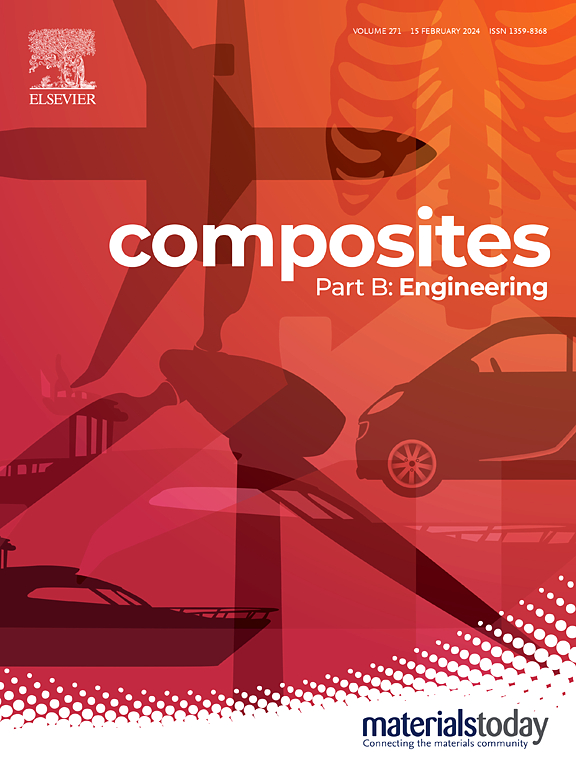Effect of non-uniform roving-matrix-CSM architecture on the flange-web interface behavior of pultruded GFRP composite members
IF 12.7
1区 材料科学
Q1 ENGINEERING, MULTIDISCIPLINARY
引用次数: 0
Abstract
Pultruded glass fiber reinforced polymer (PGFRP) composites are heterogenous compositions of glass roving, continuous strand mat (CSM) and resin matrix. Nonetheless, PGFRPs are considered to be idealized homogeneous materials for structural design. Unintended variation of roving-matrix-CSM (RMC) architecture can result in a reduction in PGFRP flexural member capacity. The objective of this study is to investigate the effect of non-uniform RMC architecture on the performance of PGFRP members subject to flexure, focusing on the failure mode characterized by cracking at the flange-web junctions of such members. This study considers five PGFRP shapes – box, I, C, T and L – and quantifies non-unform RMC architecture for 18 sections. A robust FE model capturing the individual roving and CSM layers of the PGFRP was developed, and both non-uniform and idealized uniform RMC architectures were modeled in every case allowing the effect of RMC architecture variation to be investigated. Three-dimensional Hashin damage criterion was implemented to predict the progressive failure of PGFRP materials in an accurate and repeatable manner. A parametric study varying fiber volume ratio, CSM proportion and shear span resulted in 360 separate FE models. Study conclusions demonstrate the increased sensitivity of box shapes to variations in RMC architecture with reductions in capacity compared to idealized RMC architecture exceeding 20% in some cases.
非均匀粗纱-基体- csm结构对拉挤GFRP复合材料法兰-腹板界面性能的影响
拉挤玻璃纤维增强聚合物(PGFRP)复合材料是由玻璃粗纱、连续束毡(CSM)和树脂基体组成的非均相复合材料。尽管如此,pgfrp被认为是理想的结构设计均质材料。粗纱-基质- csm (RMC)结构的意外变化可能导致PGFRP构件抗弯能力的降低。本研究的目的是研究非均匀RMC结构对PGFRP构件受弯性能的影响,重点研究这种构件的法兰-腹板连接处开裂的破坏模式。本研究考虑了五种PGFRP形状——盒形、I形、C形、T形和L形——并对18个断面的非均匀RMC结构进行了量化。开发了捕获PGFRP的单个粗纱层和CSM层的鲁棒有限元模型,并在每种情况下对非均匀和理想均匀RMC结构进行了建模,从而研究RMC结构变化的影响。采用三维哈欣损伤准则对PGFRP材料的渐进破坏进行准确、可重复的预测。通过改变纤维体积比、CSM比例和剪切跨度的参数化研究,建立了360个独立的有限元模型。研究结论表明,在某些情况下,与理想的RMC结构相比,盒形对RMC结构变化的敏感性增加,容量减少超过20%。
本文章由计算机程序翻译,如有差异,请以英文原文为准。
求助全文
约1分钟内获得全文
求助全文
来源期刊

Composites Part B: Engineering
工程技术-材料科学:复合
CiteScore
24.40
自引率
11.50%
发文量
784
审稿时长
21 days
期刊介绍:
Composites Part B: Engineering is a journal that publishes impactful research of high quality on composite materials. This research is supported by fundamental mechanics and materials science and engineering approaches. The targeted research can cover a wide range of length scales, ranging from nano to micro and meso, and even to the full product and structure level. The journal specifically focuses on engineering applications that involve high performance composites. These applications can range from low volume and high cost to high volume and low cost composite development.
The main goal of the journal is to provide a platform for the prompt publication of original and high quality research. The emphasis is on design, development, modeling, validation, and manufacturing of engineering details and concepts. The journal welcomes both basic research papers and proposals for review articles. Authors are encouraged to address challenges across various application areas. These areas include, but are not limited to, aerospace, automotive, and other surface transportation. The journal also covers energy-related applications, with a focus on renewable energy. Other application areas include infrastructure, off-shore and maritime projects, health care technology, and recreational products.
 求助内容:
求助内容: 应助结果提醒方式:
应助结果提醒方式:


